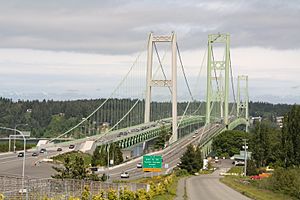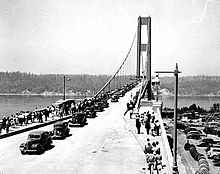Tacoma Narrows Bridge facts for kids
Quick facts for kids Tacoma Narrows Bridge |
|
|---|---|

The bridges in 2009, as seen from the Tacoma side.
|
|
| Coordinates | 47°16′5″N 122°33′2″W / 47.26806°N 122.55056°W |
| Carries | 8 lanes of |
| Crosses | Tacoma Narrows |
| Locale | Tacoma to the Kitsap Peninsula United States |
| Maintained by | Washington State Department of Transportation |
| Characteristics | |
| Design | one Suspension |
| Total length | 5,400 ft (1,645.92 m) |
| Longest span | 2,800 ft (853.44 m) |
| Clearance below | 187.5 ft (57.15 m) |
| History | |
| Opened | October 14, 1950 (westbound) July 15, 2007 (eastbound) |
| Statistics | |
| Toll | Eastbound only (passenger car): $6.00 (cash/credit price) $5.00 (transponder price) $7.00 (pay by mail) |
The Tacoma Narrows Bridge is actually a pair of two huge suspension bridges. They stretch across the Tacoma Narrows strait in Washington. These bridges connect the city of Tacoma to the Kitsap Peninsula. They carry State Route 16 traffic over the water.
When people talk about the "Tacoma Narrows Bridge," they might mean the first bridge. This original bridge opened in July 1940. It was famously nicknamed "Galloping Gertie" because it moved so much. Sadly, it collapsed just four months later due to strong winds. The name also refers to the replacement bridge. This second bridge opened in 1950 and is still used today. It now serves as the westbound lanes of the two-bridge system.
By the 1990s, more and more people were moving to the Kitsap Peninsula. This meant the 1950 bridge became very busy. In 1998, people in Washington voted to build a second bridge next to it. After some disagreements and court cases, construction started in 2002. The new bridge opened on July 16, 2007, for eastbound traffic. The older 1950 bridge was then changed to carry only westbound traffic.
Both the 1940 and 1950 bridges were among the longest suspension bridges in the world when they were built. They were the third-longest, after the Golden Gate Bridge and George Washington Bridge. As of 2017, the 1950 and 2007 bridges are the fifth-longest suspension bridges in the United States. They are also the 43rd-longest in the world.
Tolls were charged on the first bridge during its short life. They were also collected for the first 15 years of the 1950 bridge. In 1965, the money borrowed to build the bridge was paid back. So, the state stopped collecting tolls. More than 40 years later, tolls were brought back to help pay for the second bridge. Today, tolls are only collected from cars traveling eastbound.
Contents
The First Bridge: "Galloping Gertie"
People wanted a bridge here as early as 1889. But serious plans began in the mid-1920s. In 1937, the Washington State government created a special group to study building a bridge. This group was called the Washington State Toll Bridge Authority. They set aside $5,000 to look into the idea. The bridge was designed by an engineer named Leon Moisseiff.
The first Tacoma Narrows Bridge opened on July 1, 1940. It quickly earned the nickname "Galloping Gertie." This was because its deck moved up and down a lot in windy conditions. Construction workers noticed this movement.
Why "Galloping Gertie" Collapsed
The main part of the bridge collapsed into the Tacoma Narrows. This happened four months later, on November 7, 1940. The collapse was caused by something called aeroelastic flutter. This happens when wind causes a structure to twist and move in a way it wasn't designed for. A wind of 42 miles per hour (68 km/h) was blowing that day.
One reason for the collapse was the bridge's design. It had solid sides, which didn't let wind pass through. This made the bridge act like a sail, catching the wind and swaying. This swaying eventually led to its downfall. The collapse taught engineers a lot about how wind affects bridges. It led to new ways of designing long bridges to make them safer.
What Happened During the Collapse
No people were hurt or lost their lives when the bridge fell. Sadly, the only living thing lost was a dog named Tubby. He was in a car on the bridge and could not be rescued.
The collapse was filmed on 16 mm color film. This footage is famous and is often shown to students. It helps them learn about engineering disasters. The film was later chosen to be kept safe in the United States National Film Registry. This means it's considered very important for history and culture.
After the collapse, the parts of the bridge that were still standing were taken down. This work continued until May 1943. Plans to rebuild the bridge were delayed for several years. This was because of World War II and other engineering and money issues.
The Westbound Bridge (1950)
The bridge that stands today for westbound traffic was built to replace "Galloping Gertie." It was designed to be much stronger. It has open trusses and special openings in the road. These features allow wind to pass through, preventing the swaying that destroyed the first bridge.
This new bridge opened on October 14, 1950. It is 5,979 feet (1,822 meters) long. That's about 40 feet (12 meters) longer than the first bridge. Local people nicknamed this new bridge "Sturdy Gertie." This was because it didn't have the wild movements of its predecessor. This bridge, along with the newer eastbound bridge, is one of the longest suspension bridges in the United States.
When it was first built, the westbound bridge was the third longest suspension bridge span in the world. It was designed to handle 60,000 vehicles every day. It carried both westbound and eastbound traffic until the second bridge opened in 2007.
The Eastbound Bridge (2007)
In 1998, voters in Washington agreed to build a second bridge. This new bridge would carry eastbound traffic. Construction started on October 4, 2002. It was finished in July 2007. This bridge was named in honor of State Representative Ruth Fisher and State Senator Robert "Bob" Oke. They were important supporters of building the second bridge.
The Washington State Department of Transportation collects a toll to cross the eastbound bridge. The price depends on how you pay. For example, it's $5.00 for "Good to Go" account holders. It costs $6.00 if you pay with cash or a credit card. If you choose to "Pay-By-Mail," it's $7.00. The older 1950 bridge had been free of tolls since 1965. The new bridge was the first place to use the "Good To Go" electronic toll collection system.
Images for kids
See also
 In Spanish: Puente de Tacoma Narrows para niños
In Spanish: Puente de Tacoma Narrows para niños





